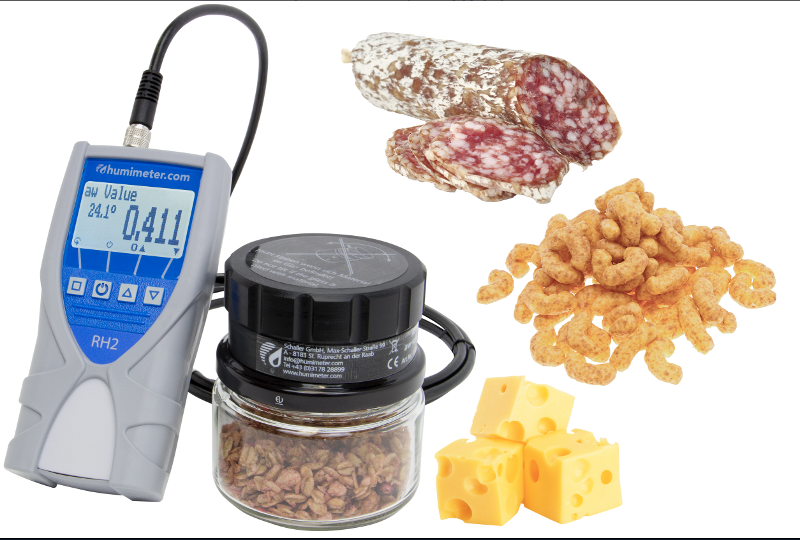Loss-On-Drying moisture analysis seemed like a simple process until, in a state of naïve bliss, I promised to look at evaporation, vapor pressure and bound water.  While I was otherwise occupied with hese realities, I offered to enter the world of witchcraft and folklore; water activity.
While I was otherwise occupied with hese realities, I offered to enter the world of witchcraft and folklore; water activity.
I offer what will hopefully be an uncomplicated definition:
The energy or escaping tendency of water.
I would be happy if I could leave it at that, but I am compelled to relate water activity to good old Loss-On-Drying. Unfortunately, the concept begins in the complex world of Boyle, Charles and Dalton and their gas laws. These populate the Ideal Gas Law with considerations of pressure, partial pressure, temperature (at Kelvin no less) volume, molecules and moles.
of pressure, partial pressure, temperature (at Kelvin no less) volume, molecules and moles.
Herein is my attempt to integrate these physics/chemistry phenomena to formulate a comprehensible description of water activity.
Let us first reflect upon a question I recently asked:
“Should we care about the presence and amount of bound water?”
The answer is very often yes and the reason frequently involves water activity.
There are many reasons water activity (aw) is important. If it is too high, it can cause spoilage, browning, mold growth, clumping and a host of other unpleasant effects. In fact, excessive aw can screw up a perfect blend of fruit and breakfast cereal (dried up fruit and soggy corn flakes).
It seems that water has an energy quotient that can lead it to enhance chemical reactions, cause bad things like bacteria growth or mix with other materials to mess up a good combination of components. Moisture content alone is not a predictor of this energy, however.
Each material has a natural relationship between moisture content and water activity, called its Moisture Sorption Isotherm (MSI) defined as:
content and water activity, called its Moisture Sorption Isotherm (MSI) defined as:
“The relationship at equilibrium between water content and the equilibrium humidity of a material.”
This is effectively a moisture fingerprint. These isotherms change with temperature so it is not a static attribute.
The implications of water activity in the food industry are related to shelf-life, contamination, health, texture and taste issues. Thus, the aw measurement is becoming an ever-increasing factor in food product design and food process quality control.
Also, water activity is becoming a serious consideration in the development and production of pharmaceutical products. It is water activity and its relationship to moisture content [not moisture content alone] that determines whether microorganisms can access water in a system, adding an important dimension to production process control.
The relationship of aw to moisture content is likewise of growing importance in other products where water action affects either the production process or a product’s physical characteristics.
Water activity measurement is a relative humidity technique; a comparison of a sample’s vapor pressure at equilibrium to that of pure water. The measurement consists of placing a sample in a closed space, waiting for equilibrium to be reached and then measuring the resulting relative humidity in the air space. This is done using a calibrated capacitance cell or a chilled mirror (a technique that gets a dew point and converts that to relative humidity). The aw number is the percentage of relative humidity divided by 100.
Knowing the MSI of a product, you can convert moisture content measurements to water activity. Loss-On-Drying results can be converted to water activity for many products. When the Loss-On-Drying process removes only -- and all -- of the water, a conversion of the moisture percentage to awcan be made with the MSI for the product.
In my  musings and reflections on the science of the gas laws and mystical scientific witchcraft of water activity, I decided that to get you past a superficial understanding of water activity, you need a more expert source.
musings and reflections on the science of the gas laws and mystical scientific witchcraft of water activity, I decided that to get you past a superficial understanding of water activity, you need a more expert source.
To get in-depth understanding about the action of water activity and how the measurements are used, I recommend Dr. Ted P. Labuza (tplabuza@umn.edu) at the University of Minnesota. He is an internationally recognized expert on water activity.
For a wider ranging examination of this segment of Moisture Analysis go to Water Activity Resources.
I hope this helped in some way to cultivate an appreciation of the implications of water activity and the relationship of aw measurement to loss-on drying.
As usual I remain a confounded,
Art
P.S. Did you know that you can subscribe to these exposés, rants, raves and ramblings? All you have to do is jot your email address in the box just to the right of the title.
P.P.S. Check out more Water Activity details and the CSC Test Kit.


